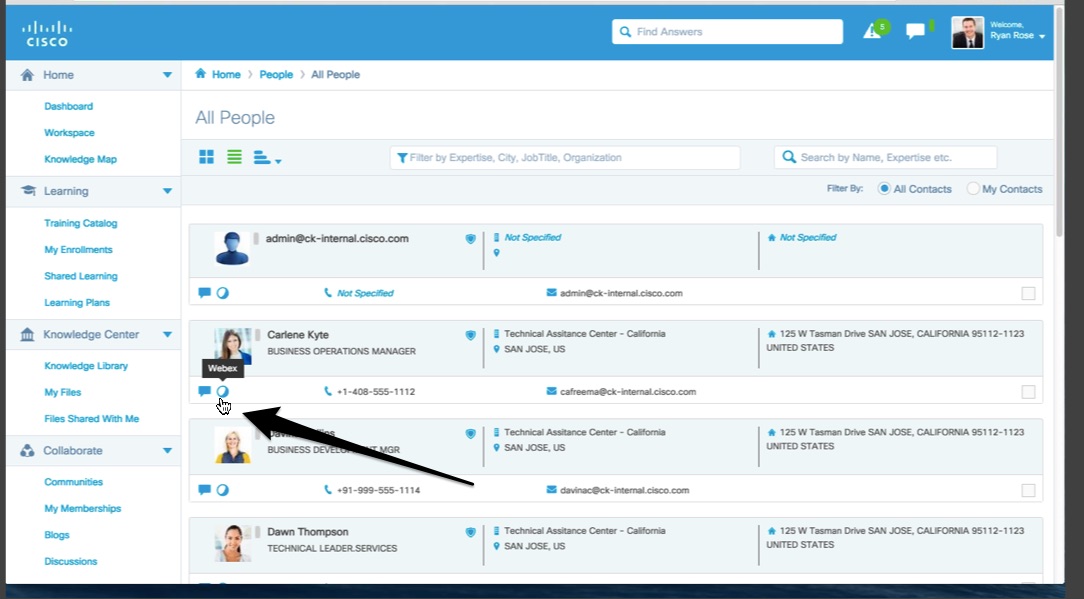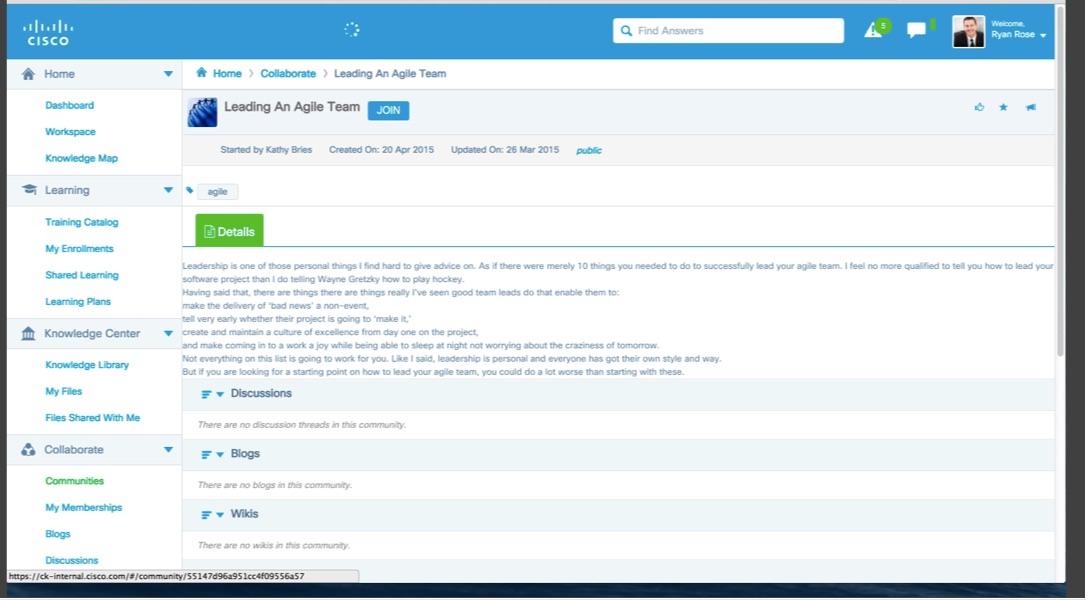Cisco, which at one time was the most valuable in the world, made an announcement that apparently got no one’s attention (outside of the venerable e-Literate). Cisco1 released a new product, Collaborative Knowledge (CK), that is designed to allow companies to access real-time expertise and enable collaborative work based on employees’ expertise, or in another word, competencies. From the press release (because I cannot find an independent news article to reference):
To be positioned for growth, performance and productivity, organizations must transform into digital workplaces where knowledge sharing, learning and talent innovation are able to occur in real-time, anytime, anywhere.
Cisco Collaborative Knowledge integrates best-in-class consumer and business technologies to enable capabilities such as highly secure knowledge sharing, expert identification, continuous learning, social networking and analytics into one complete and end-to-end enterprise knowledge exchange. With Cisco Collaborative Knowledge, workers are able to benefit from these continuous learning features, helping organizations innovate and solve real-world business challenges.
Beyond the Buzzwords, What Is It?
The key description here is “knowledge sharing, expert identification, continuous learning, social networking and analytics”. The best way to conceptualize this product is by *not* viewing it as an LMS, which in corporate circles tends to be designed around formal learning programs and learning administrators needs. Like Instructure’s Bridge product, the new new Cisco offering is designed around end user needs, and it seems to be a very different approach – not knowledge management, but employee access to knowledge, learning and networking based on expertise.
http://dilbert.com/strip/2000-06-13
Unlike an LMS, Cisco CK attempts to leverage informal, or tacit, knowledge by building up profiles of employees that include endorsed knowledge maps.
In aggregate, a company builds up a knowledge map that allows employees to browse and search.
One of the core use cases is for an employee to do a context-sensitive universal search across employees, communities, libraries and training catalogs. Once there are users identified with the endorsed skills matching a search, there is built-in capability to contact that employee by phone, email, or WebEx virtual discussion.
In another tab of results, you can find communities – which include discussions, blogs & wikis.
This product seems to hit the right notes in terms of helping end users – employees – get their jobs done; contrary to historical learning or knowledge systems that feel like forcing employees to make some learning department’s job easier. What is probably the most interesting aspect to me, in terms of corporate knowledge & collaboration, is how a full implementation of Cisco CK would reorganize a company more along personal knowledge, networking and experience and away from hierarchies and linear control.
Use in Higher Ed
During the demo, the group mostly described usage of Cisco CK within companies, or perhaps as a nod to me being in the call, “also in higher ed”. To be honest, I don’t see that the straight-forward implementation of the product suite makes sense within a college or university. While the concept makes sense on paper, universities (especially faculty) are organized into semi-autonomous departments, divisions or colleges where cross-campus collaboration is not encouraged unless for a defined academic program. I could see faculty seeing this as a time sink, not wanting to be “catalogued” and not wanting people to be able to access them with one click. I could be wrong here, but it seems like a cultural mismatch.
I could see Cisco CK applied across a discipline-specific group, but in many cases it would be difficult to know who is the purchasing entity and who is administering the system. Cisco’s example video released along with the product announcement was based on the New York Academy of Sciences, a scientific society, which somewhat backs up this supposition. There might be other direct uses in education, but likely not in higher education institutions. Let me know if I’m missing something in the comments.
https://www.youtube.com/watch?v=5wRXplqZsRc
What is relevant to higher ed in my mind, however, is not the idea of institutional implementations but rather the set of uses that could be enabled by connecting to external data sources. During the demo the team described that the system does allow access to multiple sites, but some integrations are not there, yet. If a user searches for a particular skill or competency, one of the search results will include relevant sections of the training catalog. I believe the system is designed for the primary source to be the corporate LMS here. But what if the “catalog” includes continuing education courses offered by partner institutions? What about MOOCs targeted at professional development – particularly following the concept of the Open Education Alliance or Coursera’s Specializations?
This track seems to be a real opening for educational providers – whether institutions in a continuing education role or alternative providers – to more directly connect to employers and their money. The service might not just be for courses but also for external experts as shown in the video above. This move could further blur the line between higher education and professional development.
Furthermore, let’s look at the knowledge map of each employee’s profile. Right now it seems set up to be an internal database, with Cisco providing an internal LinkedIn service for their customers. I asked if Cisco had plans to allow external definitions of the knowledge map, such as directly integrating to LinkedIn. They indicated ‘it is on the roadmap’. If that does happen, now you can see a direct mapping of actual competencies from someone’s education into company-endorsed expertise. You could be known within a company not just as ‘Sarah with an accounting degree working in corporate finance’, but as ‘Sarah with expertise on amortization and competitive analysis’.
I do not know enough about the corporate knowledge / training market to judge whether Cisco CK will be a success, but the product is intriguing. If they go down the path of integrating external data sources of training or education opportunities, and if they go down the path of acknowledging a LinkedIn definition of skills (or perhaps competencies coming from a CBE degree), then this announcement can be quite significant. This announcement would accelerate the move towards companies defining more from the demand-side on what educational opportunities they want for their employees and what skills or competencies they want from college graduates.
There is a growing movement among companies, especially technology companies, to value skills and competencies. What Cisco CK gives a view of is that this valuation is not just a matter of hiring college graduates. This valuation is moving into how a company operates and how employees are valued over time based on their acquired knowledge. Cisco CK also has the potential to offer a valuable marketplace for post-degree or alternative-to-degree education providers.
From a long-term perspective, count Cisco CK as a view towards a redefinition of what institutions and alternative educational providers produce as outputs – not just degrees and grades, but also skills and competencies and lifelong learning opportunities.
- Disclosure: Cisco, through a different division, is a client of MindWires Consulting. [↩]







IBM has (had?) a system, many years ago where collaboration was flexible (open, closed, hidden, visible, opt in, opt out, etc) to allow creative information exchange and problem solving. These types of options seem critical but seem conflicting as described for education in the Cisco materials for many of the reasons suggested in this post and more. It’s like a concept car at the auto shows-ideas that may prove workable in the future. In many ways there are pieces that can be grafted to the evolving EdX models as described in detail in Carey’s “The End of College” grafted to the many “crowd sourcing” problem solving efforts such as Amazon’s Mechanical Turk